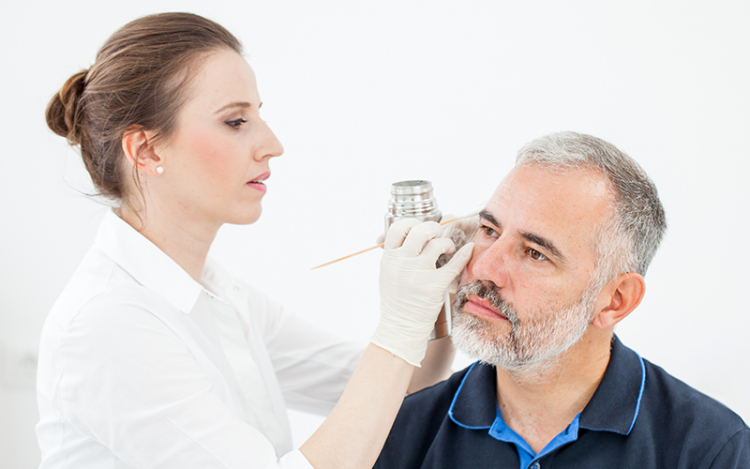Best Over-the-Counter Treatment for Actinic Keratosis

Actinic keratosis (AK), also known as solar keratosis, is a common skin condition caused by prolonged exposure to the sun’s ultraviolet (UV) rays. It appears as rough, scaly patches on the skin, typically on areas that receive a lot of sun exposure, such as the face, scalp, hands, and arms. While actinic keratosis is usually benign, it can sometimes progress to squamous cell carcinoma, a type of skin cancer. Therefore, timely and effective treatment for actinic keratosis is essential to prevent its progression.
Over-the-counter (OTC) treatments can be a convenient and accessible option for managing mild cases of actinic keratosis. The best OTC treatments available and how they can help in managing this condition.
1. Topical Creams Containing Imiquimod
Imiquimod is an immune response modifier that helps stimulate the body’s immune system to fight abnormal skin cells. While it is primarily available through prescription, some OTC products may contain low concentrations of imiquimod. These creams are applied directly to the affected areas, promoting the body’s immune response to destroy the abnormal cells associated with actinic keratosis.
How to Use:
- Apply a thin layer of the cream to the affected area, usually 2-3 times per week.
- Leave it on the skin for the recommended amount of time before washing it off.
- Follow the instructions on the package or as advised by a healthcare provider.
Pros:
- Effective for treating superficial AK lesions.
- Stimulates the body’s natural defenses.
Cons:
- May cause redness, irritation, or swelling.
- Not suitable for large areas or severe cases of AK.
2. Salicylic Acid-Based Products
Salicylic acid is a common ingredient in many skincare products, known for its ability to exfoliate and remove dead skin cells. For actinic keratosis, salicylic acid helps by softening and dissolving the keratin that builds up in the rough patches, making it easier to remove the damaged cells.
How to Use:
- Use a salicylic acid cream or solution as directed, typically once or twice a day.
- Apply directly to the affected area and allow it to dry.
Pros:
- Widely available and affordable.
- Helps in exfoliating and softening the rough, scaly patches.
Cons:
- May cause dryness or irritation.
- Not effective for thicker or more advanced lesions.
3. Alpha-Hydroxy Acids (AHAs)
AHAs, such as glycolic acid and lactic acid, are commonly found in anti-aging and exfoliating products. They work by gently exfoliating the outer layer of the skin, helping to remove dead cells and promote the regeneration of healthy skin. AHAs can be used to improve the texture and appearance of skin affected by actinic keratosis.
How to Use:
- Apply an AHA-containing cream or lotion to the affected areas once daily.
- Use sunscreen to protect treated areas, as AHAs can increase skin sensitivity to the sun.
Pros:
- Helps in smoothing rough skin and improving overall skin texture.
- Can be integrated into regular skincare routines.
Cons:
- Results may take time to become noticeable.
- Can increase photosensitivity, requiring diligent use of sunscreen.
4. Urea-Based Creams
Urea is a common ingredient in many skincare products due to its hydrating and exfoliating properties. Urea-based creams can soften the rough patches of actinic keratosis, making them easier to remove. These creams also help to retain moisture in the skin, preventing further dryness and scaling.
How to Use:
- Apply the urea cream to the affected areas once or twice daily.
- Massage it into the skin until fully absorbed.
Pros:
- Moisturizes and softens the skin.
- Helps in reducing the thickness of the lesions.
Cons:
- May cause mild irritation or a stinging sensation.
- Effectiveness varies depending on the severity of the condition.
5. Diclofenac Gel
Diclofenac is a non-steroidal anti-inflammatory drug (NSAID) that, when formulated into a gel, can be used for the Treatment of Actinic Keratosis. Diclofenac gel helps to reduce the inflammation and abnormal cell growth associated with AK. While stronger formulations are prescription-based, some OTC options might be available in lower concentrations.
How to Use:
- Apply a thin layer of the gel to the affected areas twice daily.
- Use for the recommended duration, often several weeks.
Pros:
- Reduces inflammation and promotes healing.
- Suitable for long-term use.
Cons:
- Requires consistent application for several weeks.
- May cause skin irritation or sensitivity.
Tips for Using OTC Treatments Effectively
- Sun Protection: Always use a broad-spectrum sunscreen with at least SPF 30 to protect treated areas from further UV damage. Sun exposure can worsen actinic keratosis and decrease the effectiveness of treatments.
- Moisturize: Keeping the skin moisturized can help reduce irritation and improve the efficacy of treatments.
- Monitor Changes: Keep an eye on the treated areas for any changes in size, color, or texture. If the lesions do not improve or worsen, seek medical advice.
- Follow Instructions: Use the products as directed and avoid overuse, which can lead to increased skin irritation.
When to Seek Professional Help
While OTC treatments can be effective for mild cases of actinic keratosis, they may not be sufficient for more severe or widespread cases. If OTC treatments do not show improvement within a few weeks, or if the lesions become painful, bleed, or grow rapidly, it is crucial to consult a healthcare professional. They may recommend stronger treatments, such as prescription creams, cryotherapy, or photodynamic therapy, to manage the condition effectively.
Conclusion
Actinic keratosis is a manageable condition, especially when caught early. Over-the-counter treatments such as imiquimod, salicylic acid, AHAs, urea-based creams, and diclofenac gel offer convenient options for addressing mild cases. However, it is essential to use these treatments consistently and protect the skin from further sun damage. For more severe cases or if OTC treatments are ineffective, consulting a healthcare provider for professional treatment options is recommended. Remember, early intervention is key to preventing the progression of actinic keratosis to more serious skin conditions.





